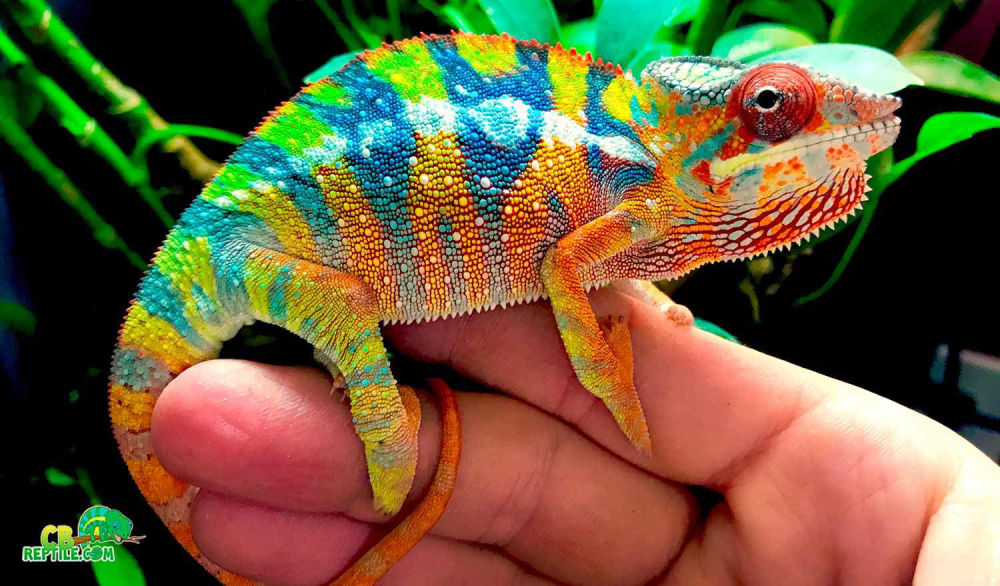Habitat and Distribution
Panther Chameleons are endemic to the island of Madagascar, with their range extending to some nearby smaller islands in the Indian Ocean. They thrive in the humid, tropical forests of Madagascar, particularly along the eastern and northwestern coasts. These regions provide the warm, moist environment that is crucial for their survival. The chameleons are arboreal, meaning they spend most of their lives in trees, which offer both camouflage and a rich hunting ground for their insect prey.
Physical Characteristics
Panther Chameleons are renowned for their spectacular coloration, which varies significantly between individuals and localities, often referred to as “locales.” These locales, such as Nosy Be, Ambanja, and Tamatave, are named after the geographic regions where distinct color morphs are found. For instance, chameleons from Nosy Be are typically vibrant blue, while those from Ambanja display a blend of blue and green hues.
Male Panther Chameleons are particularly striking, with their colors ranging from vivid reds, blues, and greens to yellows and oranges. In contrast, females are usually less colorful, often exhibiting shades of brown, peach, or pink. This sexual dimorphism is not just for show; it plays a crucial role in mating and territorial displays.
These chameleons are medium-sized, with males averaging about 17-20 inches (43-51 cm) in length, including the tail, and females being slightly smaller, ranging from 10-14 inches (25-36 cm). They possess a prehensile tail, zygodactylous feet (two toes pointing forward and two backward), and independently mobile eyes, all of which are adaptations that enhance their arboreal lifestyle.

Color Change and Camouflage
One of the most intriguing aspects of the Panther Chameleon is its ability to change color. This is not just a means of camouflage but also a way to communicate and regulate body temperature. The color change is facilitated by specialized cells in their skin called chromatophores, which contain different pigments. By expanding or contracting these cells, chameleons can alter their coloration.
Color changes can indicate a variety of conditions: a stressed or threatened chameleon might display dark, muted colors, while a content or warm chameleon might show brighter hues. During social interactions, such as courting or territory defense, males often exhibit their most vivid colors to assert dominance or attract females.
Behavior and Diet
Panther Chameleons are primarily solitary creatures. Males are highly territorial and will display aggressive behaviors, such as color changes and physical displays, to ward off intruders. They rely heavily on their keen eyesight to locate prey, which mainly consists of insects like crickets, locusts, and cockroaches. Occasionally, they might consume smaller vertebrates or plant matter.
Their hunting strategy is a blend of patience and precision. A chameleon will remain motionless, blending into its surroundings, until prey comes within striking distance. Then, using its long, sticky tongue, which can extend up to twice its body length, it swiftly captures the unsuspecting insect.
Reproduction and Lifespan
The breeding season for Panther Chameleons typically occurs during the rainy season in Madagascar, which spans from November to March. Males become more vibrant and active, seeking out females to mate. Courtship involves a series of color displays and physical posturing to win the female’s favor.
After mating, females lay a clutch of eggs—ranging from 10 to 40 eggs—buried in moist soil. The incubation period for the eggs is quite lengthy, often taking six to twelve months depending on environmental conditions. Once hatched, the young chameleons are fully independent, receiving no parental care.
Panther Chameleons have a relatively short lifespan, especially in the wild, where they typically live for 2-3 years. In captivity, with optimal care, they can live slightly longer, up to 5 years.
Conservation Status
Despite their popularity in the pet trade, Panther Chameleons face several threats in the wild. Habitat destruction due to deforestation and agricultural expansion poses a significant risk to their natural habitat. Additionally, the illegal pet trade, although regulated, can impact wild populations.
Conservation efforts are in place to protect these stunning reptiles. Madagascar has established several protected areas to preserve natural habitats, and international regulations, such as CITES (the Convention on International Trade in Endangered Species of Wild Fauna and Flora), control the export and trade of Panther Chameleons to ensure sustainable populations.
Conclusion
The Panther Chameleon is a remarkable example of nature’s diversity and adaptability. Its vivid colors, unique physical traits, and fascinating behaviors make it a subject of endless intrigue and admiration. While they continue to capture the hearts of reptile enthusiasts worldwide, it is crucial to ensure their conservation in the wild to maintain the delicate balance of Madagascar’s unique ecosystem. By appreciating and protecting these mesmerizing creatures, we contribute to the broader efforts of biodiversity conservation and ecological preservation.









